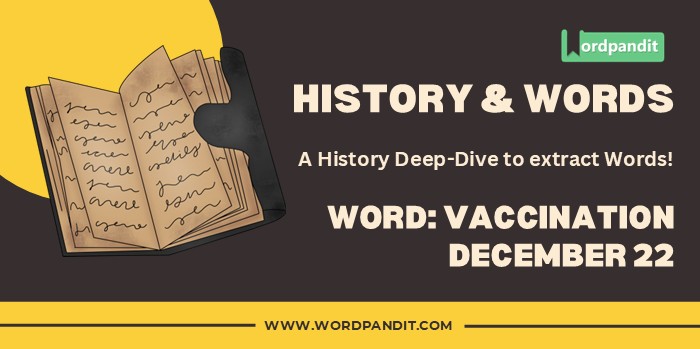History & Words: ‘Vaccination’ (December 22)
Welcome to ‘History & Words.’ 🌟 I’m Prashant, founder of Wordpandit and the Learning Inc. Network. This series combines my passion for language learning with historical context. Each entry explores a word’s significance on a specific date, enhancing vocabulary while deepening understanding of history. Join me in this journey of words through time.
📚 Table of Contents
🔍 Word of the Day: Vaccination
Pronunciation: /ˌvæksɪˈneɪʃən/ (vak-sih-NAY-shun)
🌍 Introduction
On December 22, 1891, a milestone in medical history was achieved when Dr. Edward Jenner administered the first smallpox vaccination in the United States. This event marked a crucial turning point in humanity’s fight against infectious diseases and laid the groundwork for modern immunology.
The word “vaccination” represents one of medicine’s greatest achievements – the ability to prevent deadly diseases through inoculation. This medical innovation has saved countless lives and has become a cornerstone of public health initiatives worldwide.
The development of vaccination techniques has transformed human society, dramatically reducing mortality rates and helping to eradicate devastating diseases like smallpox. This medical breakthrough continues to evolve, protecting populations from both ancient and emerging threats.
🌱 Etymology
The term “vaccination” derives from the Latin word “vacca,” meaning “cow,” reflecting its origins in Edward Jenner’s observation that milkmaids who contracted cowpox appeared immune to smallpox. The word “vaccine” was first used in 1803, and “vaccination” soon followed, specifically referring to the practice of inoculating against smallpox using cowpox material.
📖 Key Vocabulary
- 🔑 Immunization: The process of making a person immune to an infectious disease
- 🔑 Inoculation: The introduction of a pathogen or antigen into an organism to stimulate immune response
- 🔑 Pathogen: A bacterium, virus, or microorganism that can cause disease
- 🔑 Herd Immunity: Protection from infectious disease due to a large portion of a population having immunity
🏛️ Historical Context
The practice of inoculation predates modern vaccination by centuries. Ancient Chinese records describe the practice of variolation – exposing healthy people to smallpox material to prevent severe disease. This technique spread through Asia and eventually reached Europe in the 18th century.
Edward Jenner’s groundbreaking work in the 1790s transformed this ancient practice into a safer, more scientific approach. His observation that cowpox infection provided protection against smallpox led to the development of the first vaccine, revolutionizing medical science.
The 19th century saw rapid advances in vaccination technology, with Louis Pasteur developing vaccines for chicken cholera, anthrax, and rabies. These developments established the fundamental principles of immunology and vaccination that continue to guide medical science today.
⏳ Timeline
- 1000 CE: Earliest recorded use of variolation in China
- 1796: Edward Jenner performs first vaccination using cowpox material
- 1885: Louis Pasteur successfully administers first rabies vaccine
- 1891: First smallpox vaccination in United States
- 1955: Jonas Salk develops polio vaccine
- 1980: WHO declares smallpox eradicated globally
- 2020: Rapid development of COVID-19 vaccines
🌟 The Day’s Significance
December 22, 1891, represents a pivotal moment in American medical history with the first administration of the smallpox vaccine in the United States. This event helped establish vaccination as a cornerstone of public health policy in America.
The success of this first vaccination led to widespread adoption of immunization programs across the United States. These programs would eventually contribute to the complete eradication of smallpox in North America and set a precedent for future vaccination campaigns.
The implementation of vaccination programs marked a shift from reactive to preventive medicine, fundamentally changing how society approached disease control and public health management.
💬 Quote
“The good done by vaccination is not yet complete. It continues its work into endless generations, preventing disease and death in millions yet unborn.” – Louis Pasteur
🔮 Modern Usage and Reflection
Today, vaccination remains a crucial tool in public health, with ongoing research leading to new vaccines for emerging diseases. The term has expanded beyond its original meaning to encompass various methods of immunization against numerous diseases.
The COVID-19 pandemic has brought renewed attention to the importance of vaccination and the rapid advancement of vaccine technology, particularly with the development of mRNA vaccines.
🏛️ Legacy
The legacy of vaccination extends far beyond medical science, influencing public health policy, international cooperation, and global disease surveillance systems. The World Health Organization’s successful smallpox eradication campaign demonstrates the potential of coordinated vaccination efforts.
Modern vaccination programs continue to prevent millions of deaths annually and remain essential to global health security.
🔍 Comparative Analysis
While early vaccination focused solely on preventing smallpox, modern vaccination programs address numerous diseases and employ various technological approaches. This evolution reflects broader advances in medical science and our understanding of immune responses.
💡 Did You Know?
🎓 Conclusion
Vaccination stands as one of humanity’s greatest medical achievements, transforming public health and saving countless lives. From its origins in Jenner’s observations to modern mRNA vaccines, it continues to evolve and protect populations worldwide from infectious diseases.
📚 Further Reading
- 📘 “The History of Vaccines: From Smallpox to COVID-19” by Michael Kinch
- 📗 “Vaccinated: One Man’s Quest to Defeat the World’s Deadliest Diseases” by Paul A. Offit
- 📙 “The Great Influenza: The Story of the Deadliest Pandemic in History” by John M. Barry












